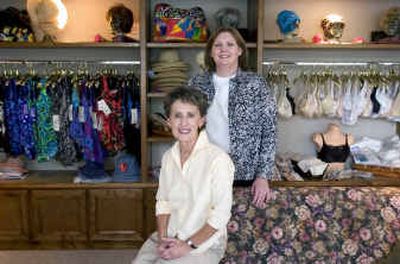COPING in style

AT FIRST GLANCE, The Essential Woman Boutique looks like any other high-end women’s clothing store. Bright-colored swimsuits hang from one rack. Lacy bras hang on another. Snow-white camisoles drape on another. There are floral-print loveseats for chatting. And airy dressing rooms with full-length mirrors. But look closer. The mannequin wearing the jog bra has no breasts. Pockets stitched in the bras hold prostheses. The camisoles have pouches for post-surgical drain tubes.
“What we’ve tried to do is just look like a normal, regular boutique,” says Londa Vaughn, the store’s manager and buyer. “The only difference is our clientele has cancer.”
The Essential Woman Boutique, which just opened its doors at 336 S. Sherman St., is one of several resources in Spokane that perform a sometimes overlooked, but important service for people — especially women — with cancer: Helping to make the outside look healthy while the inside heals.
“Your health is going to be stronger if you feel better about yourself,” Vaughn says.
Sharon Matthews, 47, started looking at wigs before she began chemotherapy in June. She wanted to be prepared when her hair fell out, so she visited the Positive Image Center, 44 W. Sixth Ave.
“You know it’s going to happen,” Matthews, who lives in Liberty Lake, said of losing her hair to chemo. “But when it does happen, it’s pretty traumatic … Part of it is because all of a sudden, you don’t feel very attractive … You look like you have cancer all of a sudden.”
The Positive Image Center, which is managed by Sacred Heart Medical Center, sells a wide range of wigs, along with hats and turbans. Licensed cosmetologists volunteer their time at the store to help women fit and style their new hairpieces, says coordinator Jan Grayhek.
Women should start thinking about buying a wig before they start treatment, Grayhek says.
“Decisions made in a crisis mode are usually not good decisions,” she says.
In September, the store will move into the hospital’s new Women’s Center and it will begin carrying breast prosthetics, along with bras and corrective makeup. The Positive Image Center also runs the Positively Pretty program, which helps adolescent girls who are recovering from cancer learn how to apply makeup and do their hair, Grayhek says.
Such resources weren’t as widely available nine years ago, when Spokane Valley resident Marilyn Taylor was diagnosed with breast cancer.
Taylor remembers grieving as though she’d lost a loved one after her double mastectomy.
“You feel ugly and it hurts and you just feel terrible,” she says, “like you’re never going to be right again.”
She eventually got prostheses (she nicknamed them “Lucy” and “Ethel”) and opted for reconstruction three years ago.
Taylor now runs Amber Coast, a business selling prosthetics and bras for breast cancer patients. The business is a mobile one, with Taylor traveling to women’s homes (“in their comfort zone,” she says) for fittings.
“If you don’t replace the weight that has been taken away, you’ll end up with back and neck problems,” she says. “Subconsciously, when you’re out and about, you always feel like people are looking and noticing that. It’s real important to get that shape back.”
As a volunteer, Taylor oversees the American Cancer Society’s “gift closet,” where cancer patients can receive donated hats, wigs, bras, prostheses and other items.
“When they call, there’s no screening as far as their financial means,” Taylor says. “If they call and say, ‘Hey, I need help,’ there’s help.”
Some insurance companies will pay for wigs, prostheses and other items, but others do not.
The American Cancer Society also runs the “Look Good … Feel Better” program, in which women going through cancer treatment meet with trained cosmetologists to learn about wigs and makeup.
“They teach the women how to cover up the cosmetic side-effects of going through treatment,” says Abby Wadlow of the American Cancer Society.
Women learn how to put on “eyebrows” if theirs fall out, how to wrap turbans, how to deal with skin made dry by chemo. They leave with a bag full of donated cosmetics and, hopefully, an extra shot of self-esteem, says Jeanette Brenner, a cosmetologist who trains others to lead the sessions.
“They all have a good time,” Brenner says. “It’s kind of like a party time.”
But all women react to the physical changes in different ways. Some, like Taylor who nicknamed her prostheses, approach it with a sense of humor. Others are embarrassed or terrified.
“This is not anything she wants to be doing,” Vaughn says of her customers.
“Some women will laugh and joke their way through the whole process. Sometimes you just need to sit down and have a cup of tea and let them cry awhile.”
Matthews, who has three kids, discovered a lump in her breast on Mother’s Day. She had a lumpectomy a week later and started chemotherapy in July. She’ll follow those treatments with radiation.
She bought a short-haired wig and a long-haired one, which she usually wears pulled back with a hat. She also has a wig without a top on it so she can wear it with hats on hot days.
“It makes you feel better about yourself,” she says. “You might not feel very well, but if you can look as healthy as possible, if you can still get out and get some exercise, it makes you feel like you’re not sick and you’re getting better.”